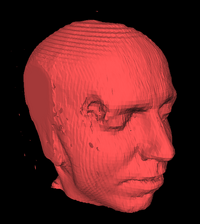Marching cubes

Imagine playing with a bunch of blocks of different shapes and colors. Now imagine you want to build a toy mountain out of those blocks. The problem is, you don't have any pre-made mountain shapes, so you have to use your creativity to make one.
This is where the idea of marching cubes comes in. Imagine you have a large pile of 3D cubes (like the blocks we were playing with), and imagine each cube is assigned a certain value based on its position in space. This value could represent anything - for example, the density of a certain material at that point in space.
Now, let's say you want to create a shape based on those values. You could use marching cubes to generate that shape. Marching cubes is essentially an algorithm that takes those 3D cubes and their assigned values, and uses them to create a continuous shape.
The way marching cubes works is by taking each cube and looking at the values assigned to its eight corners. Based on those values, it decides what configuration of triangles (made of three points each) should be used to create the surface of the shape. Then it moves on to the next cube and repeats the process.
When all the cubes have been processed, what you end up with is a continuous surface made up of many small triangles. This can be used to create all sorts of shapes - including mountains (just imagine stacking a bunch of triangles in a mountain shape).
So, while marching cubes might sound complicated, it's really just a way to use some simple math to turn a bunch of 3D cubes and values into a continuous surface made up of triangles.
This is where the idea of marching cubes comes in. Imagine you have a large pile of 3D cubes (like the blocks we were playing with), and imagine each cube is assigned a certain value based on its position in space. This value could represent anything - for example, the density of a certain material at that point in space.
Now, let's say you want to create a shape based on those values. You could use marching cubes to generate that shape. Marching cubes is essentially an algorithm that takes those 3D cubes and their assigned values, and uses them to create a continuous shape.
The way marching cubes works is by taking each cube and looking at the values assigned to its eight corners. Based on those values, it decides what configuration of triangles (made of three points each) should be used to create the surface of the shape. Then it moves on to the next cube and repeats the process.
When all the cubes have been processed, what you end up with is a continuous surface made up of many small triangles. This can be used to create all sorts of shapes - including mountains (just imagine stacking a bunch of triangles in a mountain shape).
So, while marching cubes might sound complicated, it's really just a way to use some simple math to turn a bunch of 3D cubes and values into a continuous surface made up of triangles.
Related topics others have asked about:
